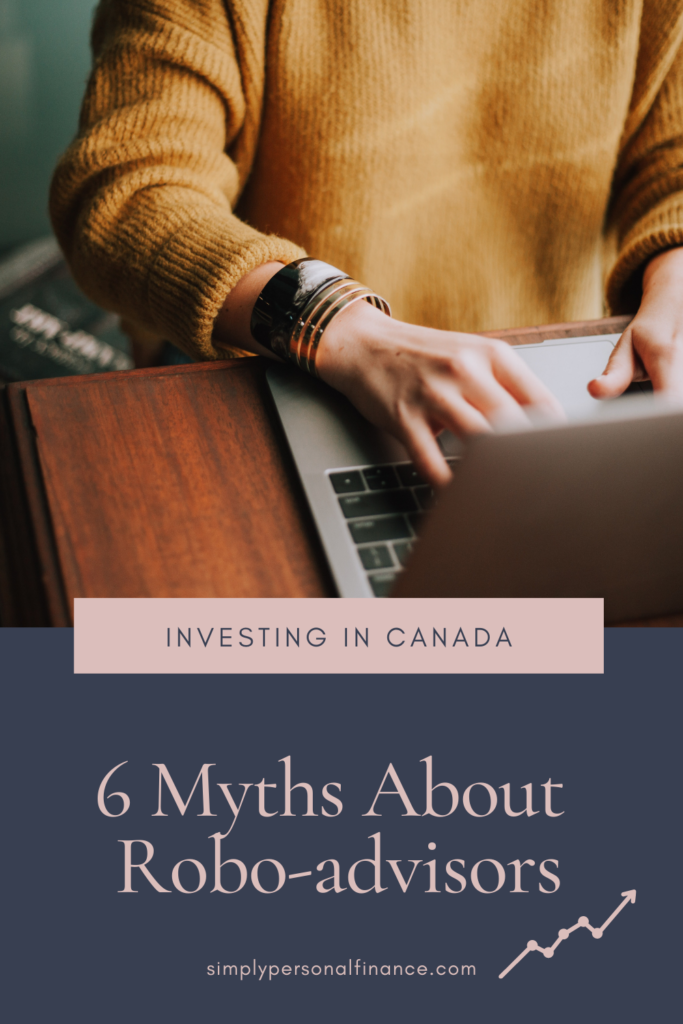You’ve probably heard about robo-advisors in Canada these days and if you’re still skeptical or unsure, you’ve come to the right place. I’m going to go over the most common misconceptions about robo-advisors.
Just to set the scene, robo-advisors are online investment services that allow customers to invest in a hands-off approach. These robo-advisors will normally invest in low-cost products like Exchange-Traded Funds (ETFs) on behalf of the customer, you! All you have to do is send the money and they will do the rest for you.
A robo-advisor is a great investment option for any beginner investor and really anyone who wants to invest in low-cost products that have a great return on investment. Robo-advisors allow the everyday citizen to invest without having to do any market research and without having a bajillion dollars in the bank. So let’s get to it… here are 6 common misconceptions about robo-advisors in Canada!
1. A robot is going to be looking over my money.
Mmm false. Your money will be invested based on an algorithm but most of the time, there is access to a human advisor if needed! There are still humans behind the scenes. Traditional investment firms may use algorithms to dictate their financial products as well so there’s nothing sketchy here… next!
2. Investing with a robo-advisor is riskier than at the bank.
Nope. And to be quite frank, investing at the bank is actually a lot riskier! Not only are you paying higher fees for worse market performances year after year, you probably don’t realize your financial advisor (aka sales person) does not have a fiduciary duty. This means that legally they do NOT have to act in their clients best interests. Guess who that is? You!
Robo-advisors in Canada are members of the Investment Industry Regulation Organization of Canada (IIROC), which requires them to have a fiduciary duty. You’re obviously going to want to check that the robo-advisor you choose is a member of IIROC before you start investing. All that means is that these guys DO have a legal duty to act in your best interest.
P.S. Any Canadian financial institution you invest money with should be a member of the Canadian Investor Protection Fund (CIPF), which protects your funds in the case of the bankruptcy of your financial institution. Make sure to look out for that insurance protection as well!
3. I’ll get better returns with my mutual funds at the bank.
It’s general practice for robo-advisors to invest in low-cost exchange-traded funds. ETFs are highly diversified funds that hold hundreds to thousands of some of the highest performing companies within a certain sector. ETFs are not actively managed as they are designed to track indexes that are following the market. A great example I like to use is the S&P 500, which is an index that tracks the 500 highest performing companies in the United States. If you buy an ETF that tracks the S&P 500, you’re essentially buying into every one of the top 500 companies in the United States, no ifs, ands or buts! To put it quite simply, you are the market so just ride that wave.
The banks on the other hand will normally make you purchase their most expensive products: mutual funds. Mutual funds are actively managed, which means that someone is sitting behind a desk making trades in the stock market and is actively trying to beat the market. Sorry to have to tell you this but in many cases, these investment managers are unable to beat the market and with those hefty fees you’re paying, there’s no way you’re going to be getting ahead in the long run.
4. Robo-advisors only offer one-size-fits-all-strategies.
There may be a few robo-advisors that will offer you one of 5 investment options, but there are definitely robo-advisors out there that offer a more personalized investment portfolio dependent on your:
- goals – are you saving for retirement or are you hoping to buy a home in the next few years?
- time horizon – when do you see yourself withdrawing the money?
- risk tolerance – for example, are you comfortable loosing $400 to gain $800 in the future or would you rather not see your money go down at all but only gain $200 in the future?
Many robo-advisors in Canada also offer socially responsible investing, where you will only invest in companies with a good track record of environmental and social responsibilities. The options are endless you simply have to do your research!
5. You need lots of money to invest.
Definitely not! You do not need to be a bajillionaire to start investing anymore.
With robo-advisors like Wealthsimple, you can open an account with as little as $1. Others like Questwealth Portfolio and BMO Smartfolio are only a minimum of $1000, which is extremely affordable compared to the old school investment firms that require hundreds of thousands of dollars just to step in the door. Robo-advisors were designed to help make investing more accessible to the everyday person and that’s exactly what they do!
6. It takes a lot of effort to set up an account.
Setting up an investment account with a robo-advisor in Canada is honestly easier than ordering takeout these days. It will definitely take you less than 30 minutes to open an account, fill out the survey and set up your banking information to deposit your funds.
You really don’t need to know everything to start investing so stop putting it off already! This is your sign!
Robo-advisors might not be the best option for people with extremely complicated tax situations or those with a very high net worth. However, if you’re looking to start out with a low-cost investment opportunity without having to do a ton of market research, robo-advisors are definitely a great option for you. We already know the earlier you start investing, the better, so let’s get to it!
*Disclaimer: I am not a certified financial professional and this should not be considered financial advice. All opinions expressed are my own. Please do your own due diligence before making any investment decisions.*
Pin it for later!









Leave a Reply